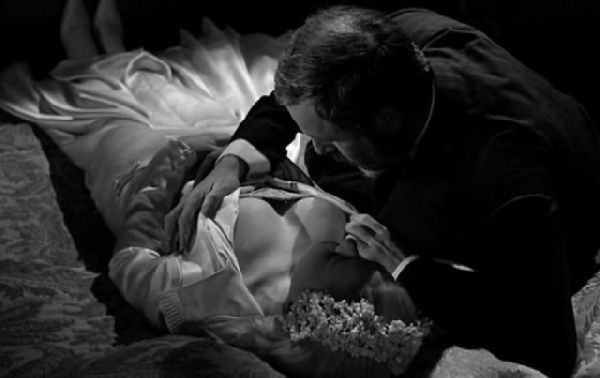Viridiana (1961) 

Director: Luis Buñuel
Cast: Silvia Pinal, Fernando Rey, Francisco Rabal
Synopsis: Viridiana, a young nun about to take her final vows, pays a visit to her widowed uncle at the request of her Mother Superior.
Viridiana (Silvia Pinel) is a rather stunning nun. She has a fresh, appealing complexion, a thick mane of blonde hair and a wonderfully full figure. There’s a reason why she looks as attractive as she does, and why she spends most of the movie being exploited and abused. In the Luis Bunuel movie that bears her name, she represents the sly old Spanish dog’s view of religion as a well-meaning and attractive but ultimately worthless institution that is defeated with a disheartening inevitability by its self-delusional belief in the natural goodness of the human condition.
Viridiana’s schooling as a nun has been paid for by an uncle (Fernando Rey) whom she has never met, and she is reluctant to pay him a visit prior to her graduation. However, under instruction from her Mother Superior, she dutifully stays a few days at his mansion. Uncle is not short of a bob or two, you see, and there’s an ever so subtle suggestion that the church has half an eye on an inheritance should the old boy die. This possibility is further suggested by the swiftness with which the Mother Superior later visits Viridiana upon learning of the old man’s death, and in the manner in which she surreptitiously surveys her surroundings as she talks to her novice.
Viridiana’s visit goes better than she expects until it’s time for her to leave. On her last day, her Uncle reveals that she bears a striking resemblance to his wife — her aunt — who died on their wedding night. He asks Viridiana to wear her Aunt’s wedding dress as a favour to him and then, after she reluctantly complies, he asks her to marry him. Naturally, Viridiana is repulsed by the idea, but after she refuses he drugs her coffee with the help of his housemaid, Ramona (Margarita Lozano) and carries Viridiana to her bedroom with the intention of ravishing her.
Unable to go through with the deed, he nevertheless tries to kid his niece into believing he has had his way with her, hoping the disgrace will force her to remain with him. His plan backfires, however, and Viridiana departs, only to be stopped by the police as she is about to board the bus to be told that her uncle has committed suicide.
The old man bequeaths his property to his niece and Jorge (Francisco Rabal), his illegitimate — and formerly estranged — son. Jorge is everything his father was not: an outgoing ladies man with a taste for the good things in life. While he and Viridiana share nothing in common, there is an inevitability about the direction in which their relationship will go. Before then, however, Viridiana busies herself with trying to help the local town’s beggars by housing them in an annex of the mansion and providing them with food in return for a little work.
Much of Bunuel’s work subsequent to Viridiana is near-impenetrable surrealism, but with this film his directness and purpose is grounded in realistic social commentary that finds its target with unerring accuracy. He uses metaphor that is brilliant in its simplicity. Witness, for example, the episode in which Jorge buys a dog that has been forced to run alongside the cart to which its collar has been tied in order to prevent itself from being choked. Having saved one dog, he fails to see a second dog suffering the same plight under a cart driving in the opposite direction. Charity is an inadequate tool in the face of such abundant cruelty.
Bunuel was invited back to Spain by Franco to make this film after an exile lasting more than twenty years, but he didn’t stay long after the film was completed. Although it was a winner at Cannes, Viridiana was banned in Spain until 1977, and was roundly condemned by the Vatican for a scene in which the thirteen beggars to whom Viridiana has offered shelter drunkenly adopt a pose for a ‘photograph’ which resembles da Vinci’s depiction of the last supper. It’s a great moment in a surprisingly accessible and thought-provoking movie which probably provides one of the easier inroads into Bunuel’s work for those who are unfamiliar with — or put off by — his reputation as a master of surrealism.
(Reviewed 18th March 2013)
httpv://www.youtube.com/watch?v=SedG8Rq_B3U
